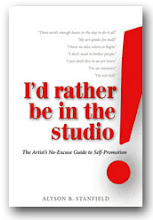Oil
6"x8"
Private Collection
I wanted to share a few tips today that I've learned over the many years on my painting journey. So, here goes in a rambling sort of way:
1. First things first: a strong composition is the most important, then value and finally color.
Take the time to do a small or several small thumbnail/value sketches, choose the strongest one. You now have a plan, have worked the basics out in your mind. If you are plein air painting it will become a reference for the shadow patterns which helps you keep to your original idea as the light changes.
For composition a great help is to take acetate and trace the outline shapes of paintings I like (I keep a scrap book of paintings I've clipped from art magazines). Darken in the darks, lightly cross-hatch the mid values. Study the arrangement of the major shapes/patterns to see how the composition is put together.
2. Premixing the major colors you are seeing can create more harmony in your paintings. You have made your plan/choices. Then you are free to apply the premixed colors, covering the canvas quickly. Then make any further additions/corrections. Whistler required his students to premix their palette. He said that if the colors look good together on your palette they'll look good on your painting...or maybe it was more like..If the colors don't look good on your palette putting them on the canvas won't help! I find that I stay more true to my original idea when I premix. Even on my little 6x6 daily paintings I premix. It helps to sharpen your observation skills.
3. Need to make a big color change in a painting but don't know if it will work? Lay acetate over the painting (should be dry to the touch). Paint the new color on the acetate. For small areas I will cut out the shape I'm thinking of changing and paint it the new color then hold it over the painting..tape it on if the painting is dry to the touch so you can step back and look. This works great, too, if you are trying to decide where to put/add a new element that wasn't in your sketch.






7 comments:
Jennifer, I enjoy your blog, and think your paintings are wonderful. Thanks for taking the time to share some of your helpful tips!
Great tips Jennifer!..
Invaluable!.. Will definitly find the ecetate one Very useful..
Thanks for sharing.. :D
Thanks, Essayer, for visiting my blog! It's fun to pass along tips.
This paintig is so rich and lovely!
Thanks, Linny. This was a little plein air piece painted in a friend's garden during our annual community library's garden tour fund raise. Our valley has some incredible gardens.
Hi Jennifer,
Just stumbled upon your posting on oil painting tips. I love the flower painting and the colors. I have learned to premix just flesh tones before I paint portraiture but it is eye opening to learn that you even premix colors for a small still life painting. It makes sense though. I think it is a good discipline. I will give it a try. I usually work with 3 colors plus white so I did not think it was neccessary to premix colors out of such a simple palette. But it is worth trying.
Thanks for the inspiration.
Connie
http://www.explore-drawing-and-painting.com
Thanks, Connie. For me, premixing my colors is about mixing the values, more important than color! Colors can be off, but if the values aren't correct the painting won't read right. It's about making decisions like "What is my darkest dark and lightest light?" Then I keep my range of values between those.
Post a Comment